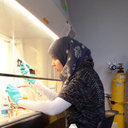Composition and Biological Activities of Murraya paniculata (L.) Jack Essential Oil from Nepal.
Mots clés
Abstrait
Murraya paniculata (L.) Jack, a small tropical evergreen shrub growing in Nepal, has numerous uses in traditional medicine for treatment of abdominal pain, diarrhea, stomach ache, headache, edema, thrombosis, and blood stasis. The present study investigated the chemical composition and bioactivities of the leaf essential oil from M. paniculata from Nepal. The essential oil from leaves was obtained by hydrodistillation and a detailed chemical analysis was conducted by gas chromatography-mass spectrometry (GC-MS). The essential oil was screened for antimicrobial activity using the microbroth dilution test, for nematicidal activity against Caenorhabditis elegans, and for lethality against brine shrimp (Artemia salina). A total of 76 volatile components were identified from the essential oil. The major components were methyl palmitate (11.1%), isospathulenol (9.4%), (E,E)-geranyl linalool (5.3%), benzyl benzoate (4.2%), selin-6-en-4-ol (4.0%), β-caryophyllene (4.0%), germacrene B (3.6%), germacrene D (3.4%), and γ-elemene (3.2%). The essential oil showed no antibacterial activity, marginal antifungal activity against Aspergillus niger (MIC = 313 μg/mL), a moderate activity against A. salina (LC50 = 41 μg/mL), and a good nematicidal activity against C. elegans (LC50 = 37 μg/mL).




